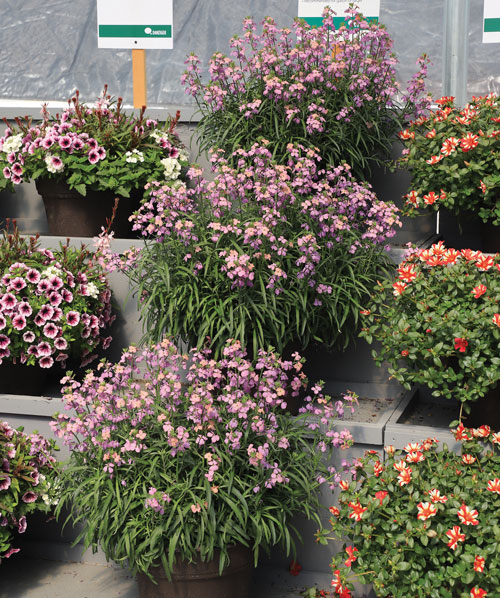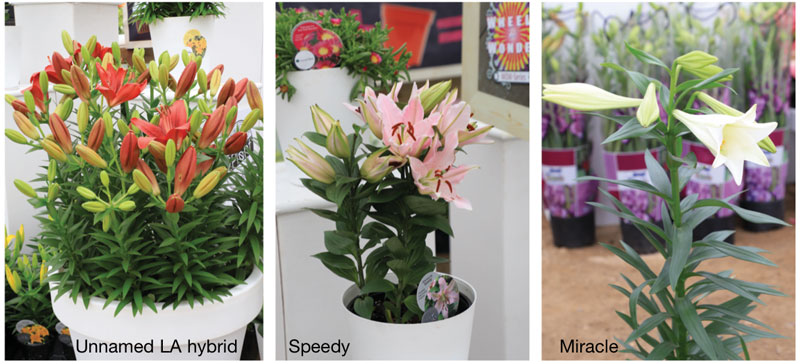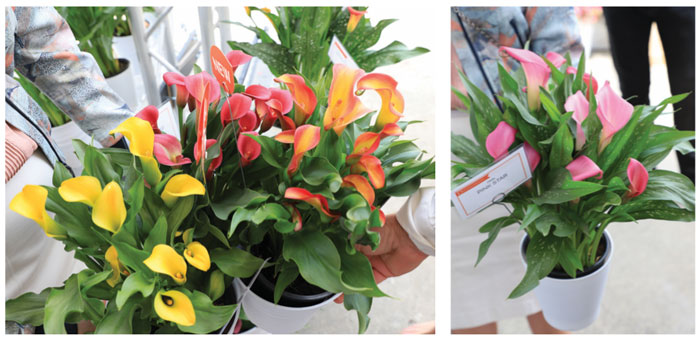8/1/2018
More of the Good Stuff
Paul Pilon, Chris Beytes, Ellen C. Wells & Jennifer Zurko
Remember when the California Spring Trials used to be exclusively about seed annuals? Then vegetative annuals hit the scene, and the floodgates opened. Now the March/April new varieties event is about virtually anything and everything you can grow in a greenhouse or nursery. All of which makes it challenging for us to decide how to organize the highlights for you.
But we think we have it figured out: Last month we brought you the best of the annual and vegetable offerings. This month, we cover perennials, woody ornamentals, potted crops and garden mums.
If there’s any crop or category we left out, well, we apologize! But it’s also the best reason to visit the Trials for yourself, even if just over the weekend. We guarantee you’ll see enough new stuff to last you several seasons. Mark your calendars for the 2019 edition of the California Spring Trials, March 23-27.
Alesco Anti-Ethylene Product (Syngenta)
Syngenta has a partnership with Chrysal, the flower preservative company (at least that’s how we think of them). Chrysal has an ethylene-blocking product called Alesco, which Syngenta has tested and found to be excellent at preventing flower loss due to ethylene. You spray it on a few days before shipping and get two weeks or more of protection from flower dropping. Effective on lots of crops, like seed geraniums, petunias and lobelia. We asked about cost for application: $85 per acre of plants … or about a penny a plant. Cheap insurance!
Plenty of Perennials

Coreopsis Golden Stardust, Super Star (Darwin Perennials)
Golden Stardust is easy to grow, producing an abundance of star-shaped red and yellow flowers. This hybrid coreopsis can be sheared to promote additional flushes of colorful blooms. Super Star has burgundy and yellow flowers. Both are mildew tolerant and don’t cycle out of bloom. Hardy to Zone 5.
Lavender Madrid Lavish Pink, Purple (Green Fuse)
Part of Green Fuse Botanical’s First Light Perennials collection, the “lavish” part of Lavish Lavender is its double-flowered or multi-bracted spikes, which make the flowers extra-large and fluffy. Green Fuse has a utility patent on the flower form. Steve Jones told us Lavish makes a good houseplant, too. Zone 7.
Penstemon Dakota Verde, Burgundy (Terra Nova)
These guys are the shortest hybrids on the market, they claim, at 18 to 24 in. rather than up to 4 ft. or more like a typical penstemon. No vernalization needed, either. And when it’s not blooming, the foliage is pretty nice! Burgundy is pictured. Zones 4 to 9.

Gaura Walberton’s Silver Fountain (PlantHaven)
From British breeder Walberton’s comes Silver Fountain Gaura. Interesting that a British breeder is breeding an American prairie native, eh? What makes it stand out in the garden is its variegated foliage—the lovely flowers aren’t even necessary! But we wouldn’t say no to those white/light pink blooms. Zone 5.
Nepeta’s Cat’s Pajamas (Proven Winners)
A unique cross of other nepeta varieties that blooms two weeks earlier! Zone 3 to 8.
Veronica Magic Show Wizard of Ahhs (Proven Winners)
Okay, this was definitely one of the best names at the Trials! Wizard of Ahhs has dark foliage with a nice balance of half flowers and half foliage. It will be replacing Hocus Pocus. Zone 4 to 8.
 Hibiscus Summerific Holy Grail (Proven Winners)
Hibiscus Summerific Holy Grail (Proven Winners)
Everyone has been looking for a dark-leafed hibiscus with red flowers. Walters Gardens has managed to breed one, and so they called it—what else?—Holy Grail. The plant they had on display wasn’t in bloom yet, but the photo they showed alongside the plant was impressive. Zone 4 to 9.
Leucanthemum Sweet Daisy collection (Dümmen Orange)
Like its predecessors, Sweet Daisy Birdy is a reliable first-year-flowering shasta daisy with uniform plant structure and deep, dark green foliage. The umbrella-like flowers with traditional white petals on the outside transitions with small frilly petals towards the golden yellow centers are a real eye-catcher in the early summer. Zone 4.
Aquilegia Kirigami (Syngenta)
Kirigami is the first series of columbine that's programmable and can truly be grown as a first-year-flowering perennial. The plants have attractive foliage and excellent flower power without vernalization. Five colors (Red & White, Rose & Pink, Deep Blue & White, Light Blue & White and Yellow) and a mixture of these colors are available. Zone 5 to 9.

Phlox Flame Pro Violet Charm (Dümmen Orange)
With its compact habit, Violet Charm grows very similarly to the other Flame cultivars, except its “Pro” status indicates it’s about two weeks earlier. Violet Charm produces massive clumps of bright bicolored violet and white pinwheel-shaped flowers that stand proudly atop its attractive green foliage. Zone 4.
 Gaura Summer Star Baby (Hishtil)
Gaura Summer Star Baby (Hishtil)
These guara are compact, with really tidy habits. The flowers aren’t too high above the foliage and the plants are full. Three are experimentals—Blossom, Cherry and White. But the one that was introduced is Summer Star Baby. This is a true dwarf, growing to maybe a foot tall. Flowers, which hover just at the top of the plant, are a rich pink. Zone 5 to 9.
Erysimum Sunstrong Bicolor Purple (Danziger)
Danziger’s erysimum needs no cooling—grow it like an annual, we were told, put it in gallons or larger, and extend your season on either end. The color is an interesting pale purple and salmon/peach. Zone 5 to 9.
Chic Shrubs

Spirea Double Play Doozie (Proven Winners)
A sterile variety that continues to bloom without having to shear it. Hardy to Zone 3.
Pyracomeles Juke Box (Proven Winners)
A cross between a pyracanthus and an osteomeles, this shiny green-leafed evergreen is something Proven Winners is touting as a boxwood alternative. Zones 7 to 9 (perhaps as far north as 6). Those of you experiencing boxwood blight might give it a try.
Leucothoe Burning Love, Callistemon Light Show Red (Sunset/Southern Living Magazine)
We always see the folks from Plant Development Services Inc. at PP&L, representing the Sunset and Southern Living magazine brands. They’ve got lots of great genetics in the programs—some of which are in both, which is impressive, seeing how the gardening regions covered by the two magazines are quite different.
They showed us two introductions we hadn’t seen anywhere else. The first, in the background, is Leucothoe Burning Love. Leucothoe is a Zone 6 to 9 evergreen shrub with narrow leaves and pretty, dark red new foliage. They say you can use it in the landscape or on a patio. Grows about 30 in. by 30 in.
In the foreground is Bottlebrush (callistemon) Light Show Red. Naturally compact, this bottlebrush has clean green foliage and pretty red flowers from early summer through fall. It’s drought tolerant, too, and gives the southwest landscape a “lush-dry” look. In other words, a nice alternative to a cactus! Zone 8.

Hydrangea Endless Summer Summer Crush (Bailey)
The fifth member of Bailey’s Endless Summer line of Hydrangea macrophylla. How important is it? Well, it’s the only raspberry-colored mophead in the reblooming hydrangea category. Summer Crush, which will be available to retailers in 2019, joins the original Endless Summer (2004), Blushing Bride (2007), Twist and Shout (2009), and Bloom Struck (2014). Zone 5.
Hamelia Lime Sizzler (Plug Connection)
A heat-loving tropical shrub known commonly as scarlet bush or firebush, this bright yellow and green variegated selection comes from Greenleaf Nursery in Texas. While best for the landscape in hot climates, Lime Sizzler will work in summer patio pots, too, we think. Zone 9.
Hydrangea Invincibelle Wee White (Proven Winners)
Called “wee” because it’s the smallest H. arborescens on the market at only 1.5- to 2-ft. tall. Zones 3 to 9.
Potted Plants & Mums
 Lilies (2Plant)
Lilies (2Plant)
2Plant is a lily distributor that’s one of two companies to have the rights to the LilyLooks genetics out of Holland (the other being Zabo Plant). 2Plant had three lily breakthroughs from LilyLooks. The first is an unnamed LA hybrid lily intended for potted production. LA is a cross between longiflora (Easter lily) and Asiatic lily. Normally used for cut flowers, and very tall, they require lots of PGRs for pots. There are five colors, but no name yet.
The second breakthrough is an oriental lily called Speedy that blooms in just 55 days, compared to the usual 90 to 100 days.
Lastly, how about a new Easter lily? I don’t know when that last happened. This one, called Miracle, finishes in just 78 days—three weeks earlier than Nellie White. It’s also naturally compact, requiring no PGRs. The bulbs are smaller, so you plant three per pot and should get nine flowers (at a lower cost than one Nellie White bulb, they say).
All three of these varieties are still a couple of years away from commercial introduction, as they build up numbers. But if you’re a lily grower, you’ll want to keep your eyes on these!
 Campanula Florentes Ambella Intense Purple (Schoneveld)
Campanula Florentes Ambella Intense Purple (Schoneveld)
That’s a long name to say it’s a good plant for both indoor and outdoor (to Zone 4 to 5) uses. It’s from cuttings. And isn’t that color something?
Cyclamen from Morel
As an exclusive supplier through Ball Seed, Morel had their display at the Ball stop in Santa Paula. A couple of new varieties include:
• Halios White Silverleaf—A larger indoor variety that’s sturdy and easy to grow.
• Smartiz Fantasia Select Red—Their small selection that would work as tabletop décor during Christmas. “Select” means it’s a bicolor.

Adenanthos Chris-Tal (Nir)
Nir Nursery, an Israeli company we’d never heard of, is a third-generation breeder of Australian native crops such as wax flower (chamelaucium) and kangaroo paw (anigozanthus) for both cuts and pots. But their most unusual offering, at least to us, is adenanthos, or coast woollybush. It’s in the proteaceae family. They have both upright and cascading forms; the new upright one is called Chris-Tal. The “Tal” is named for the owner’s wife (their son, Asaf Nir was there representing). They also call Chris-Tal the “friendly” Christmas tree because it’s just so soft—no stubby needles on this “tree”—so the “Chris” is for Christmas (much to Beytes’ disappointment—he thought he finally had a plant named after him).
Garden Mums Morgana (Ball Ingenuity)
A new five-color family for early October sales.
Crassula Stone Age Silver (Jaldety)
Crassula deceptor Stone Age Silver might look like a typical crassula, but it’s super indestructible. We tried our best to bust it up for several minutes. Nothing doing. If it can survive editors, it can survive your customers.
 Calla Lily Pink Star, Pink Arrow, Callafornia Gold, Callafornia Fiesta (Dümmen Orange)
Calla Lily Pink Star, Pink Arrow, Callafornia Gold, Callafornia Fiesta (Dümmen Orange)
Their new line of callas come from Golden State Bulb and Dutch company Sande, both of which Dümmen purchased recently. We know that Dümmen has moved bulb production from California to Holland; they say they’ll have bulbs ready to ship by Week 51.
Back in the Golden State days, we were lucky to see two or three introductions in a season; Dümmen had at least half a dozen! They aren’t messing around. New callas include Pink Star, which has pink blooms and maculated foliage; and (top photo, left to right) Callafornia Gold; Pink Arrow and Callafornia Fiesta. There will be plenty of bulbs available, too; for instance, in Pink Star, they’ve got 1.5 million bulbs! GT